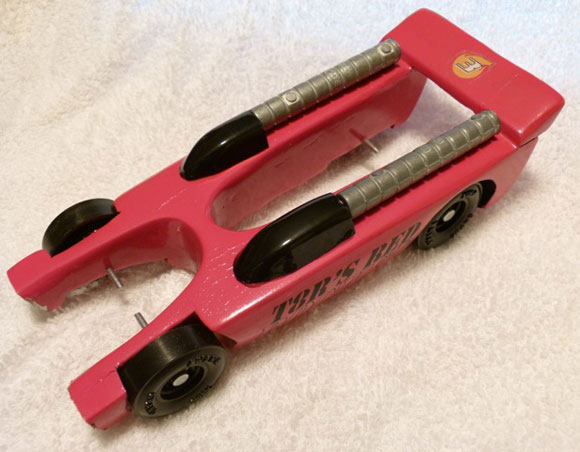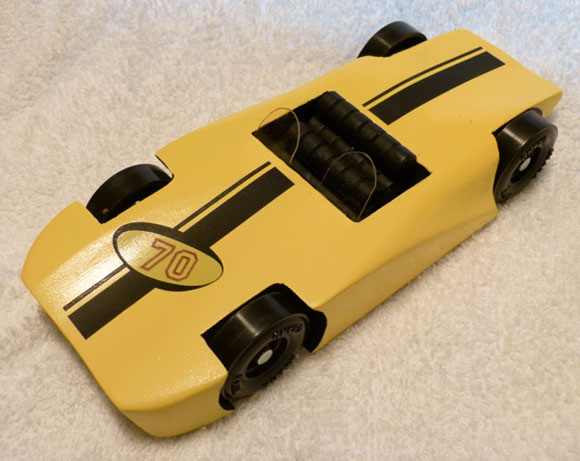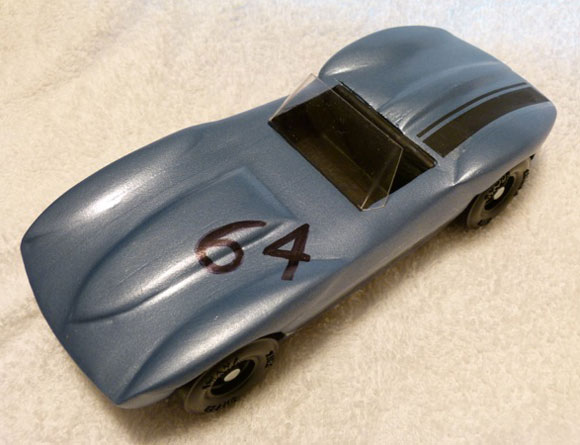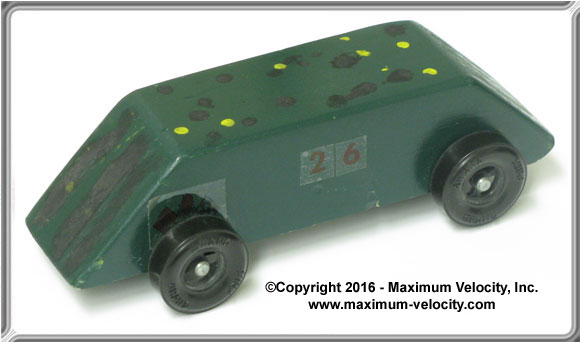– Feature Article – Five Keys to Performance
– Humor
– Pinewood Derby Car Showcase
– Memory – Third Place for Perseverance
– Q&A
Feature Article
Five Keys to Performance
By Randy Davis
(This article was last published in 2006, and I think it is time to dust it off, bring it up to date, and run it again.)
I can’t count how many times I have been asked, “What is your fastest car design?” If you have been involved in pinewood derby racing for any time at all, or if you have been a subscriber to this newsletter, then you understand that there is no car body that guarantees success. There are lots of factors that affect speed, and the car body accounts for only a few of those factors. I try to explain this, but the inquirer usually just sloughs off that answer and repeats the question.
Today I would like to go through the main factors that affect speed; and since, as a subscriber to the Pinewood Derby Times, you are astute and thoughtful I know that you won’t just slough off this information! So, let’s go through the five keys that unlock the performance of a pinewood derby car.
Key 1 – Maximize Momentum – Maximum weight; Weight towards the rear of the car
In an automobile, momentum helps the car keep rolling when you take your foot off the gas. In a similar way, momentum helps a pinewood derby car to continue rolling as fast as possible on the flat section of the track. Momentum must be maximized for top performance, and the key to momentum is weight. In each race, there is a maximum allowable weight for the car (usually five ounces, but certainly check your local rules). Momentum is maximized when your car has the maximum allowable weight for your race.
For a five ounce maximum weight, you will likely need to add two or three ounces of weight to the car. But where on the car do you add the weight? Add the weight towards the rear of the car.
Tests show that best performance is achieved on most tracks when the weight is added towards the rear of the car. This can be overdone, but a simple test to make sure the car is properly weighted is to balance the finished car on the edge of a ruler, or a balance stand. The car should balance somewhere between 3/4 and one inch in front of the rear axle.1
Does the type of weight matter? The maximum weight can be achieved with any type of weight; however, the type of weight does affect how easily the desired weight can be achieved. Denser weights (such as Lead or Tungsten) take up less space, so it is easier to reach the maximum weight. Also, since denser weights require a smaller volume of space, they allow creation of more aerodynamic cars (which is Key 2).
By the way, if you are in a BSA-sponsored race, ignore the picture on the front of the BSA kit. Use the slot closest to the end of the block as the rear axle.
Key 2 – Aerodynamics – Profile and body features minimized to improve air flow
If you had asked me several years ago, “How do I make my pinewood derby car go fast?” I would not have included aerodynamics as a key. However, since that time I have read one study and performed another, both of which showed that the effect of aerodynamics on pinewood derby car performance is not trivial (see Volume 3, Issue 9 – “The Big Debates – Aerodynamics”).
There are many elaborate ways to improve aerodynamics, but to simplify matters, let’s use the following principles:
- Low-profile cars (smaller surface area as viewed from the front of the car) will tend to outperform higher-profile cars.
- Cars should taper from a smaller surface area in the front to a (possibly) larger surface area in the rear.
- Edges running across the car should be rounded or tapered.
- Wings, sails, flags, pennants, etc. add to the surface area, thus they tend to decrease performance.
- Smooth, slick paint job.
To add some balance to this topic, Key 2 (aerodynamics) is not as important as the other four keys, so I don’t suggest that you sacrifice looks to achieve an aerodynamic shape. If your child wants to build a car that is not particularly aerodynamic, don’t worry about it. Just make sure that the other four keys are carefully followed.
Key 3 – Wheel/Axle Preparation – Axles – no flaws, straight, polished; Wheels – no flaws, polished
All of the frictional losses in a pinewood derby car come from the wheels and axles. Start by inspecting the parts in your kit to make sure they are usable. If a part has a serious flaw, replace it.
Next, prepare the nails.
- Place the nail in the chuck of a drill and use a Mini-File to remove the flashing under the nail head and minimize the ridges on the shaft. Beveling the nail head slightly is also a good idea. (If you are in a race using Awana or Maximum Velocity kits, the mini-file is not needed).
- Optionally use the Pro-Axle Press to ensure that the nails are straight and round.
- Finally, polish the axles with an Axle Polishing Kit until they are bright and shiny. Avoid overzealous sanding with coarser papers, as that will reduce the diameter of the axle (not desirable).
Depending on the type of wheels you have, the preparation steps will change. If there are flaws on the tread surface or inside edge of the wheel, then use a Pro-Wheel Mandrel and some fine grit (wet) sandpaper to polish the wheels. On some wheels, a Pro-Hub Tool can be used to round the inside wheel hub. Finally, polishing and waxing the wheel bore also reduces friction to increase performance.
Key 4 – Lubrication – Quality lubricant; applied properly
Lubrication is an extremely important key. The difference in time between a well-lubricated car and a car without lubrication can be several tenths of a second or more (this translates into several feet on the track).
Most people use graphite for lubrication. Graphite is carbon that has been processed into a fine powder. There are many varieties and qualities of graphite available at hobby and hardware stores, so make sure to get a good brand. Cheap brands have a lower carbon content and include impurities. We offer Max-V-Lube brand which is a high-purity graphite, and has been proven to produce top results in pinewood derby racing.
When lubricating with graphite, take the time to work it in thoroughly; a casual puff before the race is not sufficient. I recommend spending five minutes per wheel adding graphite, spinning the wheel, adding graphite, spinning the wheel etc. Since graphite works best after a break-in period, don’t re-lubricate between race heats. By the way, you will find it much easier and cleaner to lubricate before mounting the wheels and axles on the car.
If you use a liquid lube (such as Krytox 100), make sure to follow the recommended application procedure. With liquid lubes, less is best.
Key 5 – Alignment -Car goes straight
In order for the car to get to the finish line as quickly as possible, it needs to go straight. If it zigzags down the track, it will travel a longer distance, but worse it will continually lose speed as it bumps and rubs against the guide rail.
To minimize the amount of alignment adjustment needed, make sure that the axle slots/holes are perfectly parallel to each other and the axles are straight. Also, when using axle slots, make sure that the axles are inserted perfectly straight. The Pro-Axle Press and the Pro- Body Tool are great tools to help minimize the need to align the wheels. In addition, the Pro-Axle Guide will help you insert the wheels and axles properly.
The current thought on alignment is to implement a rail-riding strategy.2 This technique results in a car that follows the rail (straightest path to the finish line), minimizes undesirable wheel contact with the rail, and allows for more aggressive rear weighting.
Normally, with rail-riding, the two rear axles are bent upwards at 2.5 degrees, the front-left axle is raised, and the front-right axle (the “dominant” or steering axle) is bent downwards at 1.5 degrees. The rear wheels are aligned to have no toe-in or toe-out, and the dominant axle is aligned so that the car drifts left about five inches over eight feet.
If you don’t want to try rail-riding, then make sure your car runs as straight as possible.
Conclusion
There are many other things you can do to create a competitive pinewood derby car. If you want to read further, our booklet, “Speed to the Finish” thoroughly documents the techniques and tips needed to get top speed out of your car.
But whatever you do, just remember that to create a competitive pinewood derby car, make sure to use the Five Keys!
1See Revisiting the Balance Point in Volume 14, Issue 1.
2For a thorough discussion on rail-riding, please see Rail-Riding – Getting that Extra Speed in Volume 14, Issue 4.
Humor
How Many Dogs Does It Take To Change A Light Bulb?
Golden Retriever: The sun is shining, the day is young, we have our whole lives ahead of us, and you’re inside worrying about a stupid burned out bulb?
Border Collie: Just one. And then I’ll replace any wiring that’s not up to code.
Dachshund: You know I can’t reach that stupid lamp!
Rottweiler: Make me.
Boxer: Who cares? I can still play with my squeaky toys in the dark.
Lab: Oh, me, me!!!!! Pleeeeeeeeeze let me change the light bulb! Can I? Can I? Huh? Huh? Huh? Can I? Pleeeeeeeeeze, please, please, please!
German Shepherd: I’ll change it as soon as I lead these people from the dark, check to make sure I don’t miss any, and make just one more perimeter patrol to see that no one takes advantage of the situation.
Jack Russell Terrier: I’ll just pop it in while I’m bouncing off the walls and furniture.
Old English Sheep Dog: Light bulb? I’m sorry, but I don’t see a light bulb!
Cocker Spaniel: Why change it? I can still pee on the carpet in the dark.
Chihuahua: Yo quiero Taco Bulb.
Pointer: I see it, there it is, there it is, right there…..
Greyhound: It isn’t moving. Who cares?
Australian Shepherd: First, I’ll put all the light bulbs in a little circle…
Poodle: I’ll just blow in the Border Collie’s ear and he’ll do it. By the time he finishes rewiring the house, my nails will be dry.
Cat: Dogs do not change light bulbs. People change light bulbs. So, the real question is: How long will it be before I can expect some light, some dinner, and a massage?”
All of which proves, once again, that while dogs have masters, cats have servants.
Pinewood Derby Car Showcase
Today’s cars were submitted by Dennis Pemberton.
Red Car
Yellow Car
Corvette
These three cars were entered in our Awana GrandPrix. The fenders were made of poplar. The Red car won design for kids, the Corvette won for adults, and the Yellow car was fast as snot, but did not place due to a timer error.
Pinewood Derby Memory
Third Place for Perseverance
I was not very enthusiastic about my son’s first pinewood derby. But I pitched in and helped him create a very basic (ugly) car. We simply cut a wedge shaped piece of wood off the front and back of the car (resulting in a trapezoid for those of you that remember your basic geometry). It was then painted military green with some black animal spots. The car weighed less than 5 ounces, the axles weren’t polished, but we did put a drop of silicon oil on each axle. Thus, in less than an hour of work, the car was finished.
The night of the derby came, and I could quickly see that we were outclassed. But the race was organized in (what seemed to me) an unusual way. Although the track was four lanes, the race leader decided that the double elimination format could only identify the first and second place cars. So, a primary race to identify first and second place was held for each of the four classes. Then setting the winners aside, each of the four classes was raced a second time to identify 3rd place. During the primary race for our class, our entry finished somewhere in the lower half of the 25 or so entrants.
Since there were well over 100 cars total (and since the race procedure had quite a few wrinkles) it was getting rather late by the time the 3rd place races began. Many people had become frustrated (with the race procedure and with the antics of their kids) and had picked up their cars and left. So when the time came for our class to race there were only a few cars remaining in the staging area. Amazingly, my son’s car took 3rd place!
Although I realize that the result was a fluke, I must admit that I did get “pinewood derby fever” as a result of that race!
Randy Davis
Q&A
Do the hubs of the Pro-Ultralite tires I bought from you need to be polished?
Are you referring to the bore (the hole in the wheel)? If so, the bores have been machined to be round, but have not been polished. If desired, you can use Bore Polish to polish the bores, and the Pro-Bore Wax to make the surface extra slick.
The inner hubs (the part that contacts the car body) have not been polished. Generally, this area is rubbed with graphite.
When using your axle press and rail riding tool do you bend the axles before or after polishing? If it’s before, won’t the bending process harm the axle finish; and if it’s after, how do you polish bent axles?
The axles are polished before bending. When bending, put a piece of paper between the axle and the Pro-Railrider Tool (the tool is supplied with paper). That keeps the tool from marring the axle finish.
Do you have a pinewood derby-related question? If so, e-mail us your question.We answer all questions by e-mail, but not every question will appear in the Q&A section of the newsletter.
Back Issues
Are you a new subscriber, or have you missed some of the previous newsletters? Don’t miss out; all of the issues for Volume 5 through Volume 17 are posted on our web site.
Newsletter Contributions
We welcome your contributions. If you would like to contribute an article, a web site review, a speed tip, or a pinewood derby memory, please e-mail us.
Subscription Information
The Pinewood Derby Times is a free e-newsletter focused on pinewood derby racing. It is published biweekly from October through March.
If you haven’t already done so, please forward this issue to your pinewood derby friends. But please don’t subscribe your friends. Let them decide for themselves. Thanks.
If this newsletter was forwarded to you, why not subscribe to receive this newsletter. There is no cost, and your e-mail address is safe, as we never sell or share our distribution list.
To subscribe, send a blank e-mail to
pi*********************@*******st.com
You will receive a confirmation e-mail. Reply to the confirmation e-mail and you will start receiving the Pinewood Derby Times with the next issue.
Randy Davis, Editor, Pinewood Derby Times
E-Mail: in**@**************ty.com
(C)2018, Maximum Velocity, Inc. All rights reserved. Please do not reprint or place this newsletter on your web site without explicit permission. However, if you like this newsletter we grant permission, and encourage you to e-mail it to a friend.
Maximum Velocity disclaims any personal loss or liability caused by utilization of any information presented in this newsletter.
The Pinewood Derby Times is not specific to, and is not affiliated with the Boy Scouts of America, YMCA, Awana, or any other organization.
(R)Maximum Velocity is a registered trademark of Maximum Velocity, Inc.
(R)Pinewood Derby is a registered trademarks of the Boys Scouts of America.
(R)Awana is a registered trademark of Awana Clubs International.
All other names are trademarks of their respective owners.




